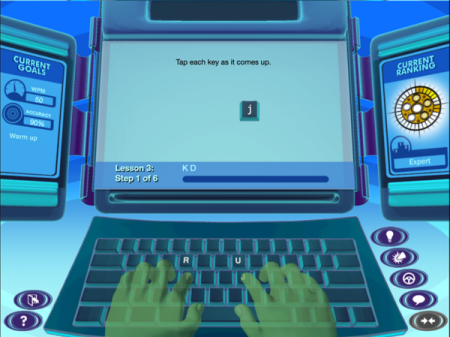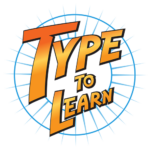- 800-356-3209
- info@typetolearn.com
- Support available M-F, 9am-5pm CT
Methodology & White Paper
Type to Learn is built upon scientific keyboarding research and teacher feedback.
A Research-Based Keyboarding Software
Keyboarding programs for schools can be fun and engaging for students while still teaching proper technique. Type to Learn is a game-based typing curriculum to ensure full student engagement. The methodology behind the success of Type to Learn was based on research by Dr. Leigh Zeitz and highlights proper technique, ergonomics, and understanding key location.
The Type to Learn program supports teachers in teaching proper technique by providing visual and auditory instructions to the students. Detailed explanations of the home row position, posture, and key stroking technique are provided in the earlier lessons, and shorter reminders are provided throughout the rest of the program.

The Research Behind Our Keyboarding Software
Leigh E. Zeitz, Ph.D.
University of Northern Iowa
Type to Learn integrated valuable input and feedback from teachers, students, and renowned keyboarding instruction expert Dr. Leigh E. Zeitz, Ph.D., an Associate Professor for Instructional Technology, Curriculum and Instruction at the University of Northern Iowa. Dr. Zeitz is a technology innovator himself, continually exploring new ways to make learning more exciting and relevant. He was a technology coordinator for six years at Price Laboratory School, and has taught at all grade levels from first through twelfth grade, plus several universities.
Dr. Zeitz has written 7 books, including Keyboarding Made Simple: Learn the Best Techniques for Keyboarding Like a Pro, authored over 60 articles and given over 100 presentations on three continents about technology and education. He maintains the Keyboarding Research website and database at www.keyboardingresearch.org and writes numerous blogs on technology and education at www.drzreflects.com. His recent research focuses on building communication skills in elementary students through keyboarding. Dr. Zeitz received his Ph.D. in Curriculum and Instruction with an emphasis on Computers-in-Education from the University of Oregon.
An Excerpt from the White Paper:
Research-Based Keyboarding Instruction for the 21st Century
By: Leigh E. Zeitz, Ph.D.
Keyboarding is an essential skill. Even during preschool years, children use computers and must be guided towards efficient keyboarding habits. Appropriate placement of keyboarding instruction in the elementary curriculum and reinforcement throughout their school years can provide the necessary foundation for the rest of our students’ lives.
Typically taught at the middle school and high school levels, Rogers’ study (2006) of Wisconsin schools showed that 85% of their schools introduce keyboarding at the elementary level. While the most popular grade levels are 3rd and 4th grade, recent years have seen successful introduction into even kindergarten classes. This early introduction reduces bad habit development and provides additional benefits that include improvements in spelling, writing, and reading comprehension.
While business teachers are primarily responsible for teaching keyboarding at the secondary levels, in 2005 over half of the keyboarding teachers at the elementary level were classroom teachers (Rogers, 2006). This can be a problem because only a small proportion of classroom teachers have any formal preparation for teaching keyboarding (Sormunen, 1991).
Keyboarding is a life long skill. It has evolved from a transcription typing skill where secretaries typed handwritten letters into a generative typing skill involving composing original thought at the keyboard (Cooper, 1983). Student writing develops faster through word processing because it facilitates the review and revision learning process. Efficient keyboarding skills allow students to emphasize concept development instead of focusing on key location.
Mastering keyboarding involves learning technique (physical positioning and movement), ergonomics (safe and comfortable keyboard interaction), and key location. Learning key location requires a sequential introduction of the keys along with a great deal of repetition and reinforcement to develop the kinesthetic memory traces leading to keyboarding automatically. Efficiency is expanded if keyboarders type short letter clusters and words as single units instead of groups of individual letters (e.g., er, ing, the, my).
Sunburst Digital’s Type to Learn software provides a research-based interactive learning environment for K-12 keyboarding learners. It is designed to guide the student and support the classroom teacher through the keyboarding skill development process. Technique and ergonomics are addressed from the beginning and reinforced throughout the curriculum. Students are placed in skill-appropriate lessons and given individualized goals and remediation based upon initial pretests and formative testing as they progress through the program. Key location is taught in cumulative sequence where new keys are integrated with previously learned skills and highly motivational activities are provided to encourage and reinforce practice. Quick-Words and Quick-Blends are letter combinations taught to optimize keyboarding efficiency. Original composition skills are developed through the many original-writing opportunities provided for the learner. Diverse student needs are addressed through multiple teacher-selected settings throughout the program. Spanish ESL students are supported through an option to provide instructions in Spanish to complete typing lessons in English. Teachers can add original content to align keyboarding subject matter with the classroom curriculum. Visual and auditory adaptations are included to extend accessibility to visually and hearing impaired students. An extensive data management system enables instructors to monitor student achievement and facilitate student progress.
Ready to see Type to Learn in action?
Let our Customer Success Team show you the basics of Type to Learn, no strings attached.
More About the Type to Learn Curriculum
Scope & Sequence
The scope and sequence of Type to Learn is based on the research outlined in the white paper. We introduce letters in small amounts and require mastery of the current lesson before advancing to learn additional letters.
Standards Alignment
Type to Learn has been directly correlated to keyboarding and technology standards in all 50 U.S. states and the District of Columbia and also aligns with the Common Core State Standards as well as those of the ISTE.
Contact a Keyboarding Specialist Today
Call us at 800-356-3209 to speak with an account manager. Get a customized quote, schedule a demo of Type to Learn, or start your 30-day free trial.


